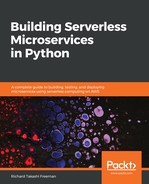At the start of my career, while I was working for global fortune 500 clients for Capgemini, we tended to use multi-tier architecture, where you create different physically separate layers that you can update and deploy independently. For example, as shown in the following three-tier architecture diagram, you can use Presentation, Domain logic, and Data Storage layers:

In the presentation layer, you have the user interface elements and any presentation-related applications. In domain logic, you have all the business logic and anything to do with passing the data from the presentation layer. Elements in the domain logic also deal with passing data to the storage or data layer, which has the data access components and any of the database elements or filesystem elements. For example, if you want to change the database technology from SQL Server to MySQL, you only have to change the data-access components rather than modifying elements in the presentation or domain-logic layers. This allows you to decouple the type of storage from presentation and business logic, enabling you to more readily change the database technology by swapping the data-storage layer.
A few years later at Capgemini, we implemented our clients' projects using SOA, which is much more granular than the multi-tier architecture. It is basically the idea of having standardized service contracts and registry that allows for automation and abstraction:

There are four important service properties related to SOA:
- Each service needs to have a clear business activity that is linked to an activity in the enterprise.
- Anybody consuming the service does not need to understand the inner workings.
- All the information and systems are self-contained and abstracted.
- To support its composability, the service may consist of other underlying services
Here are some important SOA principles:
- Standardized
- Loosely coupled
- Abstract
- Stateless
- Granular
- Composable
- Discoverable
- Reusable
The first principle is that there is a standardized service contract. This is basically a communication agreement that's defined at the enterprise level so that when you consume a service, you know exactly which service it is, the contract for passing in messages, and what you are going to get back. These services are loosely coupled. That means they can work autonomously, but also you can access them from any location within the enterprise network. They also offer an abstract version, which means that these services are a black box where the inner logic is actually hidden away, but also they can work independently of other services.
Some services will also be stateless. That means that, if you call a service, passing in a request, you will get a response and you would also get an exception if there is a problem with the service or the payload. Granularity is also very important within SOA. The service needs to be granular enough that it's not called inefficiently or many times. So, we want to normalize the level and the granularity of the service. Some services can be decomposed if they're being reused by the services, or services can be joined together and normalized to minimize redundancy. Services also need to be composable so you can merge them together into larger services or split them up.
There's a standardized set of contracts, but the service also needs to be discoverable. Discoverable means that there is a way to automatically discover what service is available, what endpoints are available, and a way to interpret them. Finally, the reasonable element, reuse is really important for SOA, which is when the logic can be reused in other parts of the code base.
